Do you think pull-ups are just a back workout? Think again.
Pull-ups are one of the best bodyweight exercises for building upper body strength. They are powerful exercises that work many muscles and help you build a stronger upper body than expected.
Understanding how a pull-up works different muscles can help you improve your exercise routine. It can also help you get the most out of your workouts and make them more effective.
Ready to become a pull-up pro? Let’s dive into the details:
- Which muscles pull-ups actually work
- How to perform pull-ups with proper form
- Effective pull-up variations to keep challenging yourself
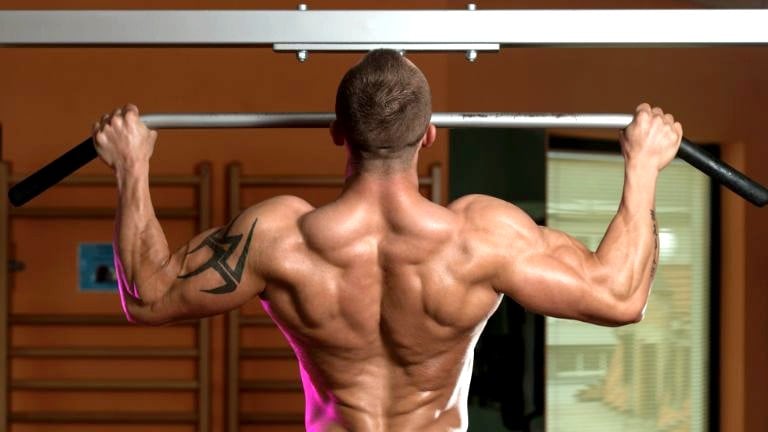
- What Is Pull-Up
- Pull-Up Muscles Worked
- Primary Muscles Worked In Pull-Up
- 1. Latissimus Dorsi (“Lats”)
- 2. Biceps Brachii
- 3. Brachialis
- Pull Up Secondary Muscles Worked
- 4. Brachioradialis
- 5. Trapezius
- 6. Rhomboids
- 7. Teres Major
- 8. Core Muscles
- 9. Serratus Anterior
- 10. Forearm Muscles
- 11. Pec Major and Tricep
- Science Behind Pull Up Muscle Activation
- How To Do Pull Up
- Common Mistakes To Be Avoided When Doing Pull-Ups
- 1. Using Momentum or “Kipping”
- 2. Incomplete Range of Motion
- 3. Elbow Flaring
- 4. Neglecting Core Engagement
- 5. Quick and Uncontrolled Movements
- 6. Over-Gripping the Bar
- 7. Focusing Only On Rep Count
- Modifications and Variations For Pull-Ups
- Making It Easier: Beginners Adaptations
- Making It Challenging: Advanced Variations
- 1. Machine Assisted Pull-Up
- 2. Isometric Holds Pull Up
- 3. Wide-Grip Pull-Ups
- 4. Weighted Pull Up
- 5. Clapping Pull Up
- 12 Pull-Ups Variations With Muscle Worked
- FAQs
- What are pull-ups good for?
- Are pull-ups good for biceps?
- Are pull-ups a compound exercise
- Takeaways
What Is Pull-Up
Pull-ups are a calisthenic and multi-joint exercise that primarily targets the upper body, including the back muscles such as latissimus dorsi, trapezius, rhomboids and shoulders, and arms.
The pull-up is a straightforward exercise that doesn’t require complex techniques or expensive gym equipment. All you need is a bar sturdy enough to support your body weight.
Pull-ups and chin-ups are often used interchangeably, but they have some differences. The main difference between the two exercises is the grip used.
- During pull-up, the palms face away from the body (overhand or pronated grip) while gripping the bar. This grip targets the back and shoulders more than the biceps.
- During chin-up, the palms face towards the body while the bar is gripped (underhand or supinated grip). This grip targets the biceps more than pull-ups.
You can perform many different types of pull-ups: assisted pull-ups, weighted pull-ups, wide-grip, and narrow-grip pull-ups, and even switch to chin-ups by simply changing the position of your hands.
Pull-Up Muscles Worked
With a pull-up, you’re not just working one or two muscles—you’re working many muscles simultaneously. Pull-ups primarily work the back and bicep but also involve many other muscle groups in the upper body.
- The main muscles worked during pull-ups are Latissimus dorsi, Biceps, brachialis,
- Other Synergists muscles worked during pull-ups are the brachioradialis, Rear deltoid, rhomboids, Levator Scapulae, Trapezius muscle groups, Pectoralis Major, erector spinae, Infraspinatus core muscles, and forearm muscles.
- Compared to a chin-up, pull-ups better engage the lower trapezius muscles.
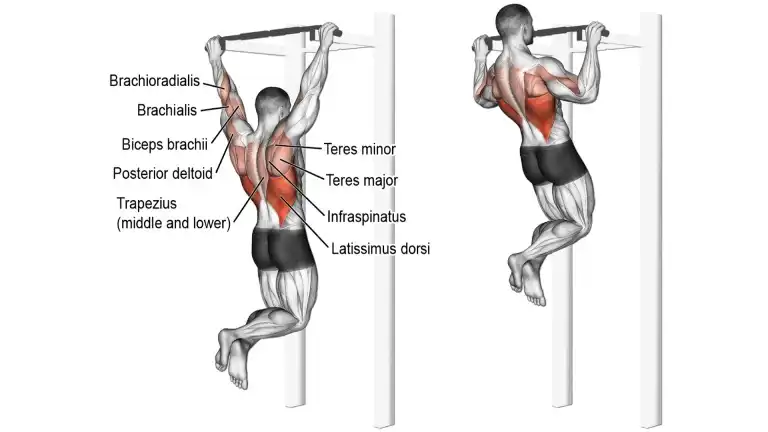
Primary Muscles Worked In Pull-Up
With a pull-up, you’re not just working one or two muscles. You’re working many muscles at the same time. However, specific muscles are the primary driving forces of the action. Here are the main muscles that pull-ups target:
1. Latissimus Dorsi (“Lats”)
The latissimus dorsi is the biggest muscle in the upper body. It is on either side of your back and goes from the lower spine and hip bone to the armpit and shoulder blade.
When you pull yourself up, your lats are the primary muscles responsible for shoulder adduction and extension. They pull your upper body up and bring your elbows toward your torso.
2. Biceps Brachii
According to a 2018 study by the Journal of Physical Fitness, the bicep muscle is the second most active muscle during pull ups.
The Biceps brachii is responsible for elbow flexion (helps you bend your elbow). When your biceps contract, they help bend your elbows and raise your body. Think about a bicep curl to see what I mean.
3. Brachialis
The brachialis is located underneath the biceps and is critical in elbow flexion.
They work in synergy with your biceps to flex the elbow, giving your pull-up that extra oomph.
Pull Up Secondary Muscles Worked
While pull-ups primarily target your latissimus dorsi and biceps, they also engage a set of secondary muscles that contribute to the complexity and efficiency of this exercise.
4. Brachioradialis
This forearm muscle originates near the elbow, runs along the forearm, and then attaches to the wrist.
The brachioradialis assists in both elbow flexion and forearm pronation. It provides additional pulling power and grip stability.
5. Trapezius
The trapezius muscle helps stabilize the shoulders during a pull-up. Different parts of the trapezius are engaged at various phases of the pull-up, helping in scapular rotation and stabilization.
The trapezius muscle aka trap muscle is a large muscle that extends from the neck down to the mid-back and outward to the shoulders.
The trap muscle is divided into three parts: the upper, middle, and lower trap. All three parts contribute to shoulder stability.
6. Rhomboids
The rhomboids are in the upper back between the shoulder blades. They are important for pulling back the shoulder muscles.
During pull-ups, the rhomboids help to pull the shoulder blades together, which helps to stabilize the shoulders.
7. Teres Major
This muscle is sometimes called the “little Lat” and works in conjunction with the latissimus dorsi to perform similar functions, such as adduction and arm extension.
While moving, the teres major assists the lats in pulling the humerus back and down, contributing to the lifting movement.
8. Core Muscles
The core muscles include the abs, obliques, and lower back. They keep the body stable and aligned while you pull up.
9. Serratus Anterior
This muscle is located on the side of the chest and is responsible for pulling the scapula back. The serratus anterior helps stabilize the shoulder blades and prevents them from winging out during movement.
10. Forearm Muscles
Pull-ups require a firm grip on the bar, which puts much stress on the forearm muscles.
When you lift yourself up and close the gap between your shoulders and forearms, the small muscles in your hands and forearms work.
11. Pec Major and Tricep
These muscles don’t play a major role in the movement, but they work synergistically with the main movers to keep you stable as you perform a pull-up.
Science Behind Pull Up Muscle Activation
Although the biomechanics and muscular engagement of pull-ups may appear straightforward, they are based on complex scientific principles.
In one of the Study, electromyographic (EMG) activation of back, shoulder, arm, and abdominal musculature measured and expressed as a percentage of maximum voluntary isometric contraction (MVIC) during a pull-up, chin-up, or rotational exercise with Perfect Pull-up twisting handles.
The muscles are:
- External oblique (EO)
- Erector spinae (ES)
- Pectoralis major (PM)
- Lower trapezius (LT)
- Infraspinatus (ISP)
- Biceps brachii (BB)
- Latissimus dorsi (LD)
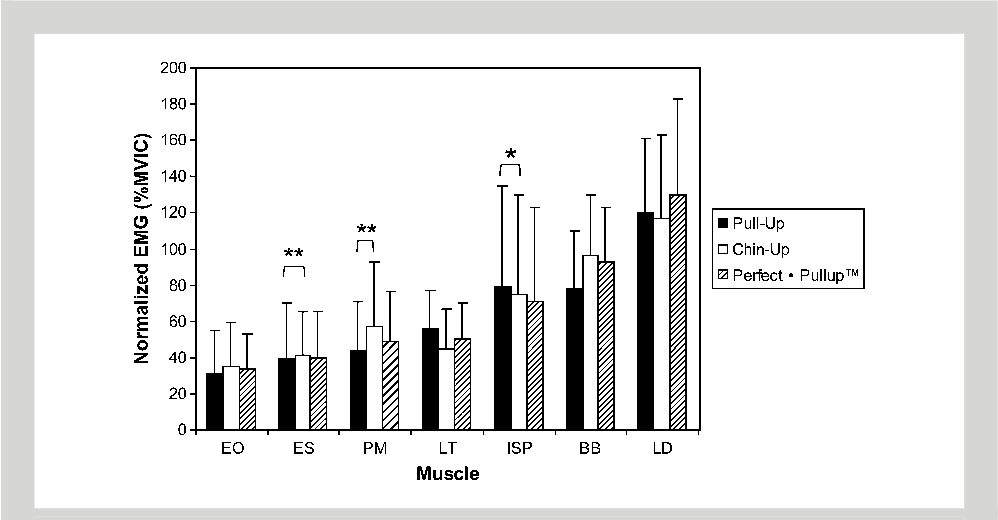
The Biceps brachii and pec major were more active during the chin-up than during the pull-up, while the back and lower traps were more active during the pull-up.
Note: In this study, the difference in muscle activation between chin-ups and pull-ups is surprisingly small.
Another useful paper for assessing the muscles worked in the chin-up and pull-up is the Electromyographic analysis of muscle activation during pull-up variations.
How To Do Pull Up
Whether you’re a beginner or simply looking to perfect your form, this comprehensive step-by-step guide will help you perform a pull-up correctly.
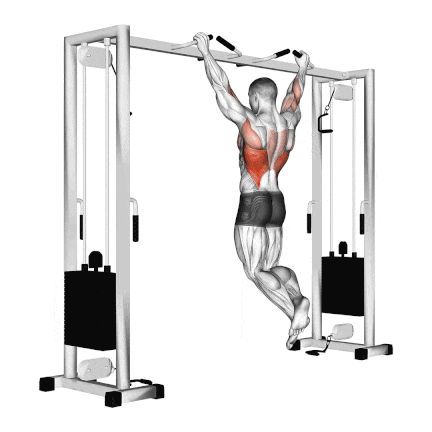
- Grab the pull-up bar with an overhand grip (palms facing away from you).
- Stand or hang underneath the pull-up bar, arms fully extended, with arms fully extended.
- Keep your core engaged, shoulders retracted and depressed, and gaze forward.
- Pull yourself up by bending your elbows and driving your elbows down towards your hips.
- Continue pulling until your chin rises above the level of the bar.
- Slowly lower yourself and fully extend your arms.
Common Mistakes To Be Avoided When Doing Pull-Ups
Pull-ups are one of the most effective upper-body workouts but can also be tough. It’s important to do pull-ups correctly to maximize their effectiveness and minimize the risk of injury.
Here are some common mistakes people often make when doing pull-ups:
1. Using Momentum or “Kipping”
The Mistake: Swinging the legs and using the momentum to propel the body upward.
Why It’s a Problem: This technique doesn’t fully engage the target muscles and increases the risk of shoulder or back injuries.
2. Incomplete Range of Motion
The Mistake is not fully extending the arms at the bottom or lifting the chin above the bar at the top.
Why It’s a Problem: Partial reps don’t provide the full benefits of muscle engagement. Over time, this could lead to imbalances or even injuries.
3. Elbow Flaring
The Mistake: Letting the elbows flare out to the sides during the upward motion.
Why It’s a Problem: This can put undue stress on the shoulders and detract from the primary focus on the back muscles.
4. Neglecting Core Engagement
The Mistake: Allowing the lower back to arch excessively or the hips to sag, indicating a lack of core engagement.
Why It’s a Problem: A disengaged core can lead to lower back pain and reduces the effectiveness of the pull-up.
5. Quick and Uncontrolled Movements
The Mistake: Pulling up or dropping down too quickly, without control.
Why It’s a Problem: Fast, uncontrolled movements make it harder to engage your muscles properly and can increase the risk of muscle strain or joint injury.
6. Over-Gripping the Bar
The Mistake: Gripping the bar too tightly or placing the thumbs on the same side as the fingers (“suicide grip”).
Why It’s a Problem: An overly tight grip can cause wrist strain and doesn’t necessarily add any strength benefits.
7. Focusing Only On Rep Count
The Mistake: Prioritizing the number of repetitions over form.
Why It’s a Problem: Poor form can lead to injuries, and it doesn’t effectively target the intended muscle groups, making the exercise less effective overall.
Modifications and Variations For Pull-Ups
Adding different variations of pull-ups to your workout routine will help keep the workout fresh and challenging.
Making It Easier: Beginners Adaptations
If you find pull-ups too challenging, don’t worry—there are several ways to make them more accessible:
- Machine-Assisted Pull-Ups: Use a pull-up machine that counterbalances your weight.
- Resistance Band-Assisted Pull-Ups: Loop a resistance band around the bar and your knees or feet to lighten the load you have to lift.
- Isometric Holds: Rather than doing complete reps, hold yourself at the peak of the pull-up or chin-up for a specified duration.
- Box or Bench Assistance: Utilize a box or bench to step up to the bar, effectively reducing the amount of body weight you need to lift.
Making It Challenging: Advanced Variations
If you’re looking to increase the difficulty of your pull-up or chin-up routine, consider the following modifications:
- Weighted Pull-Ups or Chin-Ups: Wear a weight belt or hold a dumbbell between your legs to add resistance.
- Increase Reps and Sets: Simply increasing the number of repetitions and sets will make the exercise more demanding.
- Wide-Grip Pull-Ups: Using a wider grip will make the exercise more challenging and place greater emphasis on your forearms.
- One-Arm Pull-Ups: This advanced variation significantly boosts the difficulty and focuses on unilateral upper-body strength.
- Dynamic Movements: Incorporate plyometric pull-ups to add an explosive element to your routine.
- Pause at the Top: Holding your position when your chin clears the bar can increase time under tension, making the exercise more challenging.
1. Machine Assisted Pull-Up
The machine-assisted pull-up is an excellent exercise for beginners who are not yet strong enough to perform a full pull-up.
You can use the machine to gradually reduce the amount of assistance you need until you can do a full pull-up on your own.
Machine-assisted pull-ups are not just for beginners. They can also be used in more advanced workouts, like drop sets, to make your workout more interesting and challenging.

2. Isometric Holds Pull Up
Isometric holds in pull-ups involve pausing and holding your position some points during the pull-up motion. Usually, it’s at the point where your chin touches the bar.
This static position for an extended period challenges your muscles and increases your muscular endurance.
To perform an isometric hold, start in the bottom dead hang position, gripping the pull-up bar. Then, pull yourself up to the mid-point of the pull-up and hold that position for a set time period, typically 5–10 seconds.
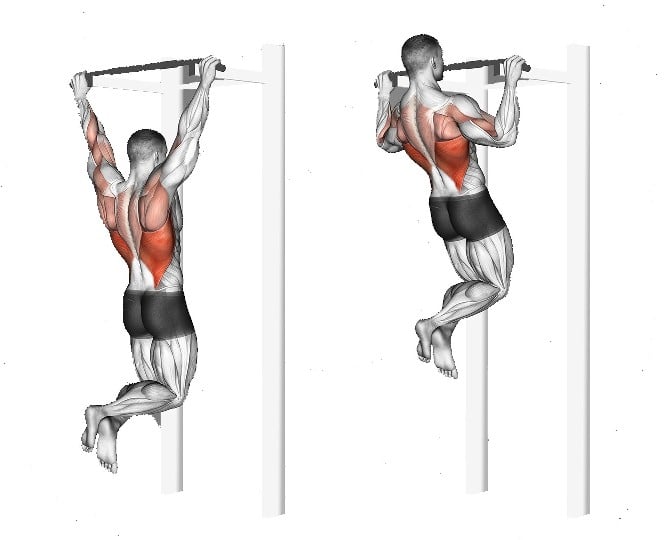
3. Wide-Grip Pull-Ups
During wide-grip pull-ups, the hands are positioned wider than shoulder-width apart on the bar. This grip variation allows for a greater range of motion and increased muscle activation in the upper back and lats.
The wide grip focuses more work on the outer lats than a standard pull-up. It helps to achieve the coveted V-shaped back.
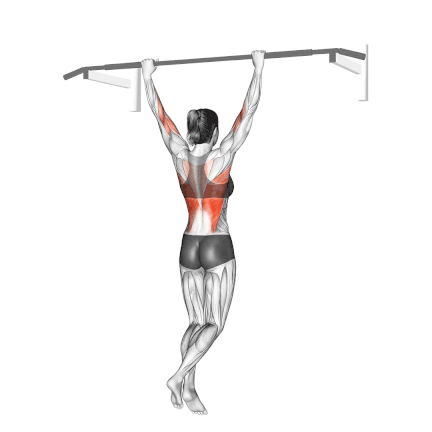
4. Weighted Pull Up
In weighted pull-ups, additional weight is added to the body during the pull-up, typically in the form of a weight belt or a dumbbell held between the legs.
The added weight increases the resistance and the difficulty of the exercise.
It’s a great way to progress from bodyweight pull-ups and chin up and to increase the intensity of the workout.
It’s also important to have a strong base of bodyweight pull-ups before attempting this variation.
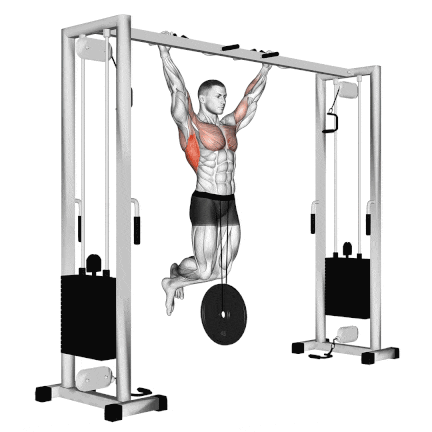
5. Clapping Pull Up
Clapping pull-ups, also known as explosive pull-ups, are a variation of pull-ups that emphasize power and explosiveness.
In this variation, you have to perform the pull-up and then explosively release your hands from the bar, clapping them together before catching the bar again and lowering yourself down.
This variation requires a significant amount of power and control to perform, but it can help increase power, explosiveness, and muscle activation in the upper body.
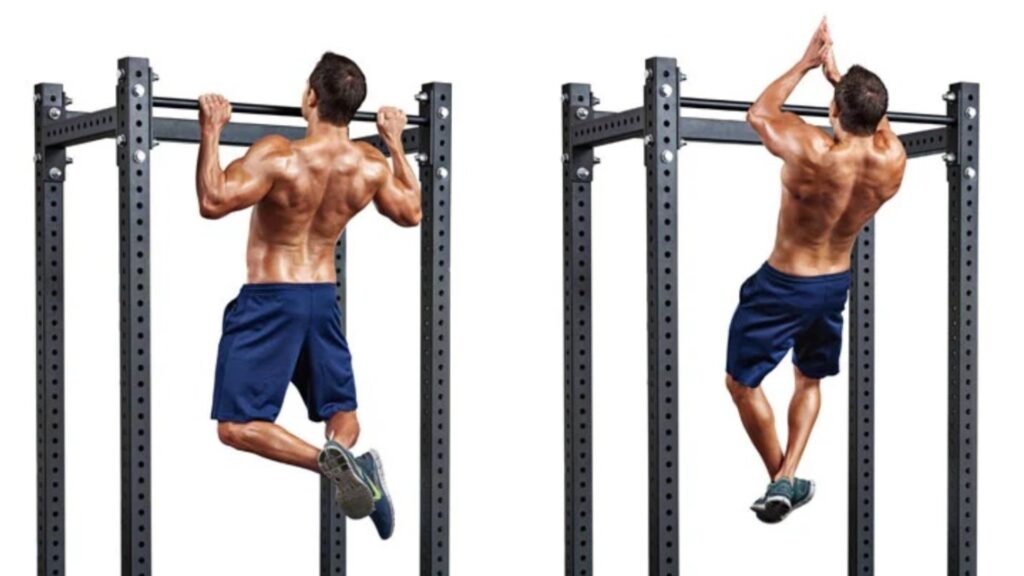
12 Pull-Ups Variations With Muscle Worked
FAQs
What are pull-ups good for?
Pull-ups are great for building upper-body strength, particularly in the back, shoulders, and arms. They also help improve grip strength and contribute to better posture.
Are pull-ups good for biceps?
Yes, pull-ups are good for working the biceps. Although they mainly work the back muscles, the biceps also help you pull your body up to the bar. For more bicep engagement, you can try chin-ups with an underhand grip.
Are pull-ups a compound exercise
Yes, pull-ups are a compound exercise that targets multiple muscle groups in the upper body. The muscles worked during pull-ups include the back, chest, shoulders, arms, and core.
Takeaways
Pull-ups are much more than just an upper-body exercise. They’re a multi-muscle move that’s great for building strength and endurance. It is a great way to strengthen your lats, shoulders, and biceps, as well as your core.
Pull-ups are a great way to build upper body strength and definition and improve grip and core strength.
So why wait? Add pull-ups to your workout routine today and see how they can transform your strength and physique.
References:
- Hewit, Jennifer. (2018). A Comparison of Muscle Activation during the Pull-up and Three Alternative Pulling Exercises. Journal of Physical Fitness, Medicine & Treatment in Sports. 5. 10.19080/JPFMTS.2018.05.555669.
- James W Youdas Collier L Amundson, Kyle S Cicero, Justin J Hahn, David T Harezlak, John H Hollman: Surface electromyographic activation patterns and elbow joint motion during a pull-up, chin-up, or perfect-pullup™ rotational exercise. J Strength Cond Res 2010 Dec.
- Ronai, Peter M. and Eric P. Scibek. “The Pull-Up.” Strength and Conditioning Journal 36 (2014): 88-90.
- Antinori, F., Francesco Felici, Francesco Figura, Marco Marchetti and Benjamin Ricci. “Joint moments and work in pull-ups.” The Journal of sports medicine and physical fitness 28 2 (1988): 132-7.

Manish is a NASM-certified fitness and nutrition coach with over 10 years of experience in weight lifting and fat loss fitness coaching. He specializes in gym-based training and has a lot of knowledge about exercise, lifting technique, biomechanics, and more.
Through “Fit Life Regime,” he generously shares the insights he’s gained over a decade in the field. His goal is to equip others with the knowledge to start their own fitness journey.
